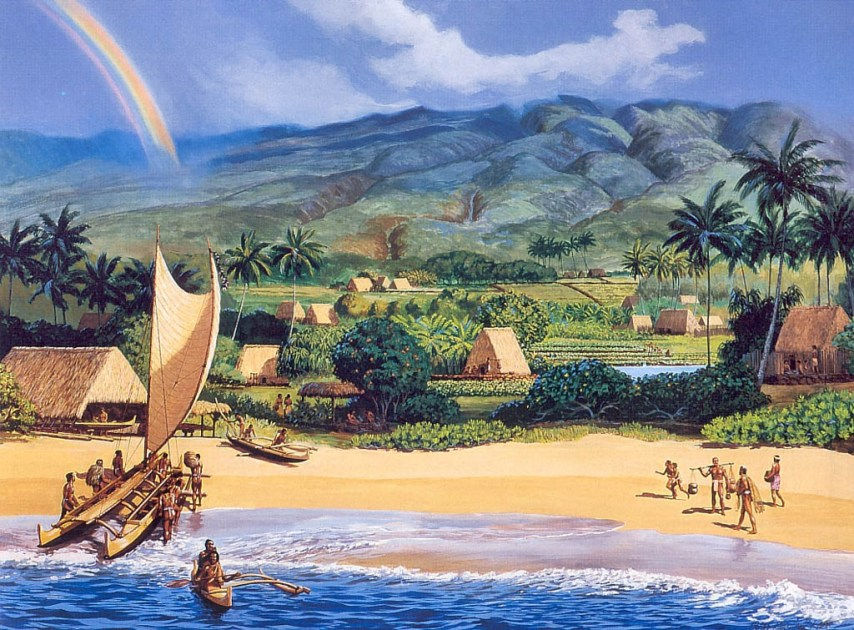Article: Hawaiian Food of the Gods
- Peter T. Young
- 1 de fev. de 2019
- 3 min de leitura

Ka’anapali 200 Years Ago-(HerbKane)
According to the theory underlying Hawaiian natural philosophy, all natural phenomena, objects and creatures, are bodily forms assumed by nature gods or nature spirits.
Thus, rain clouds, hogs, gourds, and sweet potatoes were ‘bodies’ of the god Lono. Taro, sugar cane, and bamboo were bodies of the god Kāne.
Bananas, squid, and some other forms of marine life were bodies of Kanaloa. The coconut, breadfruit, and various forest trees were bodies of Kū.
Wherever it was possible to grow taro, even though it necessitated complex arrangements, Polynesians did so, for taro was the basic – the original – staple of life for these people.
So far as the Hawaiians are concerned, the place of the taro in the diet, in the horticulture, and in mythology, makes this evident.
Taro as the staff of life, the land which provided subsistence, the people who dwelt on it, the ritual and festival in honor of the rain god …
… the role and place of fresh water upon which the life of food plants depended, the dedication of boy children to the gods of food production and procreation.
These provided the basic patterns of Hawaiian culture.
The fundamental patterns of this culture are determined by the habits of growth and cultivation of taro.
The terms used to describe the human family had reference to the growth of the taro plant: ‘aha, the taro sprout, became ‘ohana, the human extended family.
Taro, which grew along streams and later in irrigated areas, was the food staple for Hawaii, and its life and productivity depended primarily upon water.
The fundamental conception of property and law was therefore based upon water rights rather than land use and possession. Actually, there was no conception of ownership of water or land, but only of the use of water and land.
The term for land had reference to subsistence: ‘āina, ‘ai to feed, with the substantive suffix na. The people who dwelt or subsisted on the land were the ma-ka-‘ai-na-na, ‘upon-the-landers.’ And a native in his homeland was a ‘child of the land,’ kama-‘āina.
The fundamental unit of territory was the ahupua‘a, so called because its boundary is marked by an altar, ahu, dedicated to the rain god Lono …
… symbolized by a carved representation of the head of a hog, pua‘a, which is a form of Lono, the rain god and patron of agriculture.
The life of taro was dependent upon water. In his role as life-giver, Kane the procreator was addressed as Kane-of-the-water-of-life (Kane-ka-wai-ola).
Water (wai) is so associated with the idea of bounty that the word for wealth is waiwai. And water rights were the basic form of law, the Hawaiian word for which was ka-na-wai, meaning ‘relative to water.’
Although women cultivated small sweet-potato patches by the shore and in the vicinity of dwellings, farming was essentially men’s work.
With their digging sticks they prepared land for cultivation, excavated and constructed ditches and lo’i (irrigated terraces) for wet taro …
… and cleared land on the slopes and in the upland where dry taro was planted along with sweet potato, breadfruit, banana, and sugar cane.
The breadfruit is another of the Polynesian staples that was brought from Malaysia into Polynesia. Breadfruit is spoken of as ‘ai kameha‘i, meaning that it is a food (‘ai) that simply reproduces itself ‘by the will of the gods,’ that is, by sprouting. It is not planted by means of seeds or slips. (From Handy, Handy & Pukui)
Follow Peter T Young on Facebook








































Comentários